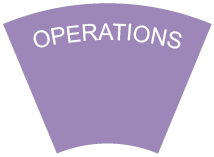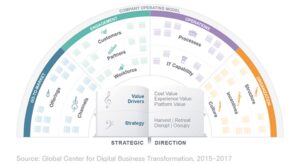
This is the third in a 4-part series of articles about digital disruption by the Global Center for Digital Business Transformation (DBT Center), a joint initiative of IMD business school and Cisco. The series explores how digital disruption is altering traditional competitive dynamics in virtually every industry – and how to ensure your company thrives.
Think about the word concert. Did you picture an event where people gather to see and listen to a set of musicians – perhaps a heavy metal band or a string quartet (we’re not here to dictate taste)? What if we were to say in concert? Together. And that’s what a concert – the kind you pictured – is all about. Your heavy metal band, string quartet, or – as we’re going to talk about, orchestra – has to work together for you to enjoy their music. In this series, we’ve looked at the competitive reality of the Digital Vortex, along with our 2017 update assessing the positioning of various industries within this Vortex. We’ve looked at what you need to understand about firms in this environment, including yours, before establishing and implementing a plan to thrive in the Vortex. Now we’ll see specifically how you can compose a Digital Orchestra to play together harmoniously, based on our June 2017 publication “Orchestrating Digital Business Transformation: Working in Concert to Achieve Digital Excellence”. Beware – becoming a digital leader takes a… concerted effort.
The figure below shows a sneak peek at what we’re going to discuss in this article. You’ll recognize the “score” sheets in this image from what you learned in last week’s article. The music your orchestra will play is meant to execute your strategies (harvest/retreat/disrupt/occupy) to drive value (cost value/experience value/platform value). Now let’s look at that orchestra – the sections of players set to play in concert for successful digital business transformation.
The sections of a Digital Orchestra
A real orchestra is composed of four instrument sections: strings, brass, woodwinds and percussion. Our Digital Orchestra framework likens four groupings of operating-model elements to these four sections. Together – playing in harmony – these can execute your company’s digital business transformation.
Your company will call upon the sections in different ways, at different times compared to another firm. It’s vital to understand which sections must be “played” when, for how long. You’ll have your own chords and melodies. Here are the sections and what’s important to know about each.
 |
This refers to what you will offer and how you will get it to your customer base.
Instruments:
|
 |
In the digital age, the way that you engage with your stakeholders changes. This includes both tools to use and manners to understand and approach them.
Instruments:
|
 |
You may need to rethink your strategy to support your company’s operations to align with your target-state business models.
Instruments:
|
 |
A new operating model capable of success in the Vortex will require organizational changes in terms of structure and ethos.
Instruments:
|
Be the maestro of your own orchestra
Our orchestra analogy provides a framework, but it is never one-size-fits-all. Companies in your industry and/or of your longevity may be similarly placed within the Vortex, but where you are is unique to you. Your orchestra and the music you play will be unique. How much or how little you develop and change each operational section, as well as when and how they play, must be prioritized based on your own Vortex-engaging strategies and the value you aim to drive. You must become the maestro.
It’s not an easy process. But the rewards can be outstanding. In the final article of this series, we will look at the Digital Orchestra experience of one company that transformed their business and orchestrated bravo performances both within and beyond their industry: McLaren Applied Technologies.
Research Information & Knowledge Hub for additional information on IMD publications
In the 2010s, card processing – Mastercard’s flagship service – started showing signs of commodification as new, nimble players (typically, fintech startups thriving on digital) entered the payment processing space, and customer preferences evolve...
Improvements in technology have made deepfakes — fraudulent audio, video, and images — easier than ever to create. As a result, 2024 has seen a nearly 60% surge in phishing attacks. These attacks hijack our perceptions and our ability to distingui...
Design thinking is an experience-based and user-centric method for solving problems. This human-centered approach engages end-users and employees in a multi-step, ongoing process of co-creation, to understand and meet evolving needs. The method is...
Although humans constitute a pivotal dimension of the cyber security attack surface, prevailing approaches are often ineffective at addressing human risk. From the vantage point of three key socio-behavioural perspectives, a critical analysis of c...
Digital product innovation (DPI) is critical for the survival of firms, especially those operating in traditional industrial-age industries. While research has started to investigate digital innovation in family firms (FFs) considering them as a m...
The global race for dominance in generative AI is intensifying, with tech giants vying for supremacy in this transformative arena. While U.S. companies like OpenAI, Nvidia and Google lead the charge, and China boasts contenders such as Baidu and A...
IMD World Competitiveness Center Report, 14 November 2024, 8th edition
Research Information & Knowledge Hub for additional information on IMD publications
Research Information & Knowledge Hub for additional information on IMD publications
Research Information & Knowledge Hub for additional information on IMD publications
Research Information & Knowledge Hub for additional information on IMD publications
Research Information & Knowledge Hub for additional information on IMD publications
Research Information & Knowledge Hub for additional information on IMD publications
in Forbes.com 6 September 2024
Research Information & Knowledge Hub for additional information on IMD publications
in Cyber Security: A Peer-Reviewed Journal September 2024, vol. 8, no. 1, https://doi.org/10.69554/UEEV5385
Research Information & Knowledge Hub for additional information on IMD publications
in Entrepreneurship Theory and Practice 28 August 2024, ePub before print, https://doi.org/10.1177/10422587241268029
Research Information & Knowledge Hub for additional information on IMD publications
Research Information & Knowledge Hub for additional information on IMD publications


